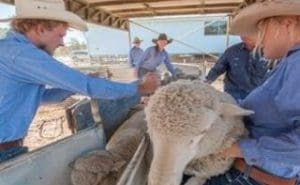Latest listings on Jobs Central recruitment page:
- Beef Boning Room Super.,Afternoon – Australian Meat Group
- Development Officers(2), WA – DPIRD
- Feeder/Stockperson, Feedlot Qld – Talbingo Pastoral Co
- Skilled Meat Workers – Australian Country Choice
- Station Manager, Glengyle SW Qld – Hancock Agriculture
- Sales – Graduate/Trainee – Bindaree Food Group
- Marketing & Comm.Specialist, John Deere – Via Rimfire Resources
- National Sales Manager, Consumer Products – Via Rimfire Resources
- National Sales Manager, Crop Solutions – Via Rimfire Resources
- Senior Territory Manager, Vic/Tas – via Rimfire Resources
- National Marketing Manager – via Rimfire Resources
- NRM Project Officer, Mt Isa – Southern Gulf NRM
- Farm Manager, Gippsland – via Rimfire Resources
- Beef Export Sales Manager – Australian Country Choice
Click here to access these and other exciting meat and livestock supply chain jobs currently listed on Jobs Central.
YOU have selected the most suited and ‘cream-of-the-crop’ new employee and you’re getting ready to welcome the new addition to your team.
While this might be the most exciting and satisfying part of the recruitment process in any agri-business, it’s certainly not the easiest. Getting the final steps right is crucial to ensuring your new recruit flourishes in their role.
Reference checking
There’s one last thing to do before you make that job offer: reference checks.
As a minimum, its worth speaking with at least two referees for at least ten minutes each. This is crucial for gaining insight into something that simply can’t be gauged through an interview – what is the person like to work with on a daily basis?
As such, the ideal referees are former colleagues or managers of the candidate.
As with interviews, it’s best to go into reference checks with a prepared set of questions. On top of confirming the referee’s relationship with the applicant, you should also endeavour to find out:
- Their perceived strengths and development areas
- How well they handle conflict
- Which management approaches seem to work well for them
- How well they get on with peers
- How trustworthy, reliable and punctual they are.
Before making these calls, ensure you have permission from the candidate to do so. If that hasn’t been included in a CV or cover letter, you will need email confirmation that they are happy for you to contact their referees.
Making the offer
Once everything is locked in and you’re sure you’ve found the one, don’t waste any time making that call. It’s a competitive job market out there and quality candidates in the red meat and livestock supply get swooped up very quickly.
Make a verbal offer, including salary and benefits and see if the person will commit verbally. It’s important to show enthusiasm, but also be empathetic if they can’t accept right away and give them a reasonable timeline to respond.
After your discussion on the phone, follow up quickly with the formal letter of offer. Letter of offer essentials include:
- Start date
- Position title
- Work hours
- Pay structure and amount
- Any entitlements and leave allowances
- Probation period details (if applicable)
- Conditions of employment.
Further details can be left for the full employment contract if you prefer.
At the very least, show appreciation for each candidate’s time that had applied for the job and wish them the best with their job hunt. You may also choose to offer feedback on their application and interview, or invite them to apply again in the future if they were only narrowly beaten.
On-boarding
Job accepted, and new staff member is ready to get started – it’s time to hang up your ‘Recruiter’ hat and get back to work as usual, right? Not quite. On-boarding may occur post-hire, but it’s undeniably a key factor in making sure your new employee can shine in their role – regardless of whether it is as a single staff-member in a family grazing operation, or working in a feedlot employing 30.
Every moment you spend helping them integrate quickly and effectively into your business is not time wasted – especially if it prevents them from being one of the 31pc of Australian employees who quit within six months.
When preparing for their first day in the workplace, consider:
- Sending a personal welcome from the team
- Choosing a colleague to act as their mentor/guide during the first few weeks or months
- Making sure their workspace, computer and log-in details(if applicable to the role), passwords/usernames and necessary programs are set up and ready to roll
- Preparing a welcome kit that outlines important procedures and explains how to do key tasks.
The new employee’s first day should feel special. Having everything set up and ready for them will certainly help them feel welcome and part of the team.
Source: Meat Processors Pty Ltd


HAVE YOUR SAY